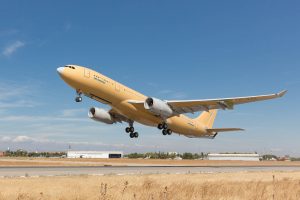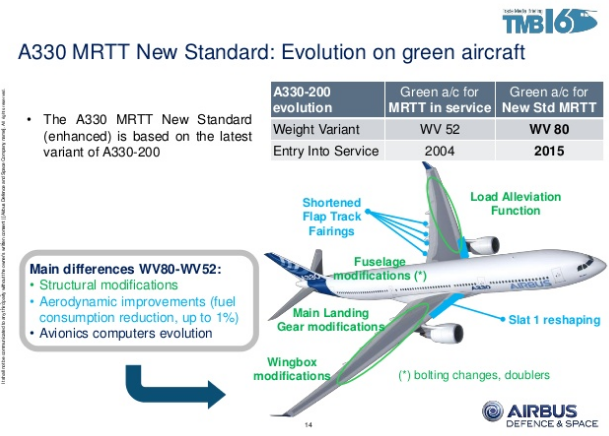2016-10-04 According to a press release dated October 3, 2016, Airbus Defence and Space announced that the first new standard A330MRTT has taken its maiden flight.
Airbus Defence and Space has successfully completed the maiden flight of the first new standard A330 MRTT Multi Role Tanker Transport.
This model incorporates a number of enhancements introduced on the basic A330 as well as upgraded military systems as part of Airbus and Airbus Defence and Space’s continuous product improvement programme.

The three-hour flight took place on 30 September and the crew reported that the aircraft performed in line with expectations.
The new standard A330 MRTT features structural modifications, aerodynamic improvements giving a fuel-burn reduction of up to 1%, upgraded avionics computers and enhanced military systems.
First delivery is due in 2018.
A total of 51 A330 MRTTs have been ordered by 10 nations of which 28 have been delivered.
During the Trade Media Event held in Munich Germany last June, a senior Airbus and Defence official discussed the changes associated with the evolution of the 330 commercial aircraft systems as well as the military systems onboard the A330MRTT.

The tanker is in the hands of several operational air forces, and as such is becoming an established global fleet.
The user groups are key drivers for further change in the program, and the correlation with the A330 means that innovations driven from the commercial sector can be applied as well to the military derivative, the A330 tanker.
The global nature of the fleet and its operations means that shared experiences are being generated and shared by the users.
The certification leader – the Royal Australian Air Force – in facts has de facto certified a number of aircraft for other users.
The brief by Amador was different from past presentations to the media at the annual Trade Media Briefing (this was the 7th) in that is was really not a company business development presentation but an overview on the operational experience of the Air Forces using the aircraft and its implications for the further development of the aircraft.
In other words, rather than comparing the aircraft to others in the marketplace, it was an overview on the operational experience of the global fleet, which is a measure of the progress of the program itself.
Currently, there are 27 A330MRTT in services with more than 85,000 flight hours, which include 40,000 in the past year.
The Aussie experience was highlighted in which one RAAF tanker has been deployed to the Middle East since September 2014 with 631 sorties flown which is a monthly average of 30 plus and more than 5000 flight hours with a monthly average of 250.
Saudi Arabia has recently completed a flight test campaign to certify their AWACs as well as their legacy tanker, the KE-3.
Amador then focused on the further evolution of the tanker or what he called it as “more than a tanker.”
Progress is occurring on the automatic refueling system, the addition of wideband sitcom, avionics upgrades and enhance self-protection options.
He highlighted that the user groups were key shapers of the way ahead in terms of demand and shared experiences.
He then focused on how the evolution of the A330 itself was shaping new performance capabilities for the tanker variant, notably in terms of structural modifications, aerodynamic improvements with reduced fuel consumption and avionics computer evolutions.
In short, the Airbus tanker is part of the US and allied operational force and as the Marines told the Aussies in the Middle East, it is the tanker of choice.

